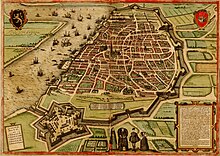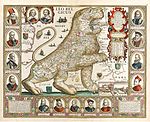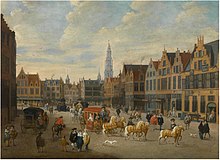Timeline of Antwerp
The following is a timeline of the history of the municipality of Antwerp, Belgium.
Prior to 13th century[]
- from abt. 150 – abt. 250-270: Gallo-Roman settlement in the centre of Antwerp (at "Willem Ogierplaats").[1][2][3]
- abt 700: Oldest mention of the name Andoverpis in a written source : the Vita Eligii dated early 8th century (abt. 700).[4]
- 739: death of Saint Willibrord, bishop.[5]
- 978: Treaty of Margut-sur-Chiers, between France and German empire, the river Scheldt is recognised as the border between Neustria and Lotharingia[6]
- 980 - the German Emperor Otto II awarded Antwerp a margraviate, and build a fortification on the wharf (de burg) with a ditch the "burchtgracht"
- 1100 The Roya is a small natural river that runs outside the "Burchtgracht"
- 1104 The fortification of the "Burcht" is reinforced by Emperor Hendrik IV. The wall's height in increased from 5 metres (16 ft) to 12 metres (39 ft) its thickness from 1.35 metres (4.4 ft) to 2 metres (6.6 ft)
- 1109: Antwerp starts making city canals the "ruienstelsel" From the Koolvliet in the north via, Holenrui, Minderbroedersrui to Suikerrui and Botervliet in the south
13th–15th century[]
- 1250 - Construction of the second Vleeshuis, city butchery and Guildhouse of the butchers[7]
- 1406 - City becomes part of the Duchy of Brabant.
- 1442 - Guild of Saint Luke granted privileges.
- 1477 - Quaeye Werelt revolt
- 1478
- 1481 - Matt. Van der Goes sets up printing press.[9]
- 1491 - One of the world's "first" illustrated advertisements printed in Antwerp.[10]
16th century[]

City of Antwerp, 1572
| History of Belgium |
|---|
 |
|
Timeline |
- 1503 - Construction of the third Vleeshuis, current building, city butchery and guildhouse of the butchers .[11]
- 1513 - Guild Hall of the Archers built.[12]
- 1515 - Joyous Entry of Charles V, Holy Roman Emperor into the city.
- 1518 - Notre Dame Cathedral built.[13]
- 1520 - Het Steen fortress rebuilt.
- 1523 - Church of St. Andrew built.[12]
- 1528 - Merten de Keyser (printer) in business (approximate date).[14]
- 1531 - Opening of the Bourse of Antwerp, the first purpose-built exchange.[12]
- 1533 - Lancelot II of Ursel saves the Cathedral from total ruin.
- 1543 - Music publisher Susato in business.[15]
- 1549 - Philip II of Spain visits city.[16]
- 1552 - Girls' orphanage built.[12]
- 1555 - Christophe Plantin (printer) in business.[17]
- 1560s - Antwerp Citadel built.[18]
- 1565 - City Hall built.[12]
- 1566 - August: Protestant Reformation riots.[citation needed]
- 1567 - 13 March: Battle of Oosterweel occurs near city.
- 1568
- Anthony van Stralen, Lord of Merksem, former mayor is executed..
- Maison Hanseatique built.[12]
- Population: 125,000.[12]
- 1570 - Theatrum Orbis Terrarum atlas published.
- 1571 - Church of St. Paul built.[12]
- 1572 - Antwerp Citadel completed.
- 1576 - 4 November: during the Sack of Antwerp, John III van de Werve, Lord of Hovorst gets killed by the Spanish forces,.[12]
- 1577 - Antwerp Citadel partially dismantled.
- 1579
- City joins Union of Utrecht.
- Hall of the Coopers built.[12]
- 1583 - 17 January: François, Duke of Anjou tries to take city.
- 1584 - July: Siege of Antwerp begins.
- 1585Defeat of the rebels on the Kouwensteinsedijk, 26 May 1585
- 1589
- Church of the Capuchins built.
- Population: 55,000.[12]
- 1593 - Hieronymus Verdussen (printer) in business (approximate date).
- 1594 - Joyous Entry of Archduke Ernest of Austria into the city.
- 1599 - Isabella and Albert (Habsburg Netherlands sovereigns) make their Joyous Entry into the city.[19]
17th–18th centuries[]

Carnival on Ice at the Kipdorppoort Moats, c. 1620
- 1603 - Nicolaas II Rockox builds the Rockox House.
- 1609 - Twelve Years' Truce signed.
 View of the Meir in Antwerp. Painting by Erasmus de Bie
View of the Meir in Antwerp. Painting by Erasmus de Bie - 1615 - Church of Augustinians built.[12]
- 1621 - Carolus Borromeuskerk built.[12]
- 1635 - Joyous Entry of Cardinal-Infante Ferdinand into the city.[20]
- 1638 - 20 June: Battle of Kallo.
- 1644 - House of the Tailors rebuilt.[12]
- 1646 - Hall of the Carpenters rebuilt.[12]
- 1646 - Siege of Antwerp by Frederick Henry failed.
- 1648
- River Scheldt closed to navigation per Treaty of Münster.[13]
- Joyous Entry of Archduke Leopold Wilhelm of Austria into the city.[21]
- 1656 - St. James' Church built.[12]
- 1663 - Royal Academy of Fine Arts founded.
- 1745 - Royal Residence built on the Meir.
- 1746 - Osterrieth House built on the Meir.
- 1750 - Royal Horticultural and Agricultural Society exhibitions begin (approximate date).[22]
- 1755 - Royal Palace built.[12]
- 1790 - Population: 40,000.[12]
- 1795 - City becomes capital of French département Deux-Nèthes.
19th century[]

Fish market, c. 1833
- 1802 - Quays built on Schelde River.[12]
- 1805 - City Library opens in City Hall.[23]
- 1810 - Royal Museum of Fine Arts founded.
- 1811 - Bonaparte Dock built.
- 1813 - Willem Dock built.
- 1815 - City becomes part of the Kingdom of the Netherlands.[13]
- 1816 - Jewish Community established.
- 1818 - Fortresses built.[13]
- 1826 - Orangery built in the Botanical Garden.[citation needed]
- 1830
- Conflict between Belgian insurgents and Dutch forces.[13]
- Population: 73,506.[12]
- 1832 - November–December: City besieged by French forces.[12]
- 1834
- 1843 - Zoological Garden founded.[25]
- 1846 - Population: 88,487.[13]
- 1848 - Jan Frans Loos becomes mayor.
- 1852 - Wuyts art gallery opens (approximate date).[26]
- 1853
- 1859
- 1860 - Kattendijk built.[13]
- 1864 - Museum of Antiquities opens.[28]
- 1866 - Cholera epidemic.
- 1867 - School of Music founded.[29]
- 1870 - Fort Merxem constructed.[13]
- 1871 - International Geographical Congress held.
- 1872 - Exchange building and Flemish Theatre built.[12]
- 1873 - Horsecar trams begin operating.
- 1874 - Demolition of Antwerp Citadel begins.[12]
- 1876 - founded.[30]
- 1877 - Plantin-Moretus Museum opens.
- 1879 - Population: 173,600.[12]
- 1880 - Royal Antwerp Football Club formed.
- 1881 - Antwerp Water Works constructed.
- 1883 - Library building opens.
- 1884 - Royal Atheneum (school) built.[31]
- 1885
- Exposition Universelle d'Anvers (world's fair) held.
- Temperance conference held.[32]
- 1891 - Gazet van Antwerpen newspaper begins publication.[33]
- 1892 - Société Anversoise du Commerce au Congo in business.
- 1893
- (Flemish Opera) founded.[34]
- Hollandse Synagoge built.
- 1894 - Exposition Internationale d'Anvers (world's fair) and Universal Peace Congress[35] held.
- 1895 - Compagnie Belge Maritime du Congo in business.
- 1896 - National Archives' Antwerp branch founded.[36]
- 1897 - newspaper begins publication.[33]
- 1898 - Royal Conservatory established.[37]
20th century[]

Bond of the City of Antwerp, issued 18. Mai 1917
- 1902 - Electric trams begin operating.
- 1903 - World Gymnastics Championships held.
- 1904 - Museum Mayer van den Bergh built.
- 1905 - Antwerpen-Centraal railway station and "America dock"[13] open.
- 1906 - Fort Breendonk built.
- 1907 - Eisenmann Synagogue built.
- 1910
- Population: 361,723.[13]
- St. Boniface Church consecrated.
- 1914 - September–October: Siege of Antwerp; German occupation begins.[38][39]
- 1920
- 1921 - Schoonselhof cemetery established.
- 1923 - Airport opens.
- 1928 - Antwerpsche Diamantkring established.
- 1930 - Eeuwfeestkliniek (hospital) built.
- 1931 - Antwerp Book Fair begins.
- 1932 - Boerentoren built.
- 1933 - Museum of Flemish Literature founded.
- 1940 - May: German occupation begins.
- 1944
- 4 September: Liberation by the British 11th Armoured Division.
- October–November: Battle of the Scheldt.
- 1946 - Rubens House museum opens.
- 1966
- Sporthal Arena built.
- Wide White Space Gallery opens.
- 1967 - Antwerp International School established.
- 1968 - De Tijd newspaper begins publication.[33]
- 1969
- Jazz Middelheim festival begins.
- Kennedytunnel opens.
- Royal Ballet of Flanders established.
- 1970 - Chicagoblok built.
- 1975
- Antwerp Pre-metro begins operating.
- International Gemological Institute headquartered in city.
- 1977 - 't Fornuis restaurant in business.
- 1981 - Zeno X gallery opens.[42]
- 1983 - Berchem, Borgerhout, Deurne, Ekeren, Hoboken, Merksem, and Wilrijk become part of the city of Antwerp.[43]
- 1985 - Museum of Modern Art founded.[citation needed]
- 1989 - Berendrecht Lock constructed.
- 1994
- Laus Polyphoniae festival begins.
- Switel Hotel fire
- 1995 - City website launched (Digitale Metropool Antwerpen).[44]
21st century[]
- 2003
- Patrick Janssens becomes mayor.[45]
- University of Antwerp established.
- 2004
- Fotomuseum Antwerp opens.
- City designated a UNESCO World Book Capital.
- 2006
- 0110 concert held.
- FelixArchief (city archives)[46] and Law Courts building open.
- 2007
- Antwerp World Diamond Centre established.[47]
- shopping center opens.[citation needed]
- 2011
- Museum aan de Stroom opens.
- Population: 507,007.
- 2013 - Bart De Wever becomes mayor.
See also[]
- History of Antwerp
- List of mayors of Antwerp
- List of schools in Antwerp
- List of parks in Antwerp
- Timelines of other municipalities in Belgium: Bruges, Brussels, Ghent, Leuven, Liège
- History of urban centers in the Low Countries
References[]
- ^ Stadsarcheologie, Tony Oost 1976-1982, site 'Stadsparking'
- ^ Oost, Tony: De bewoning te Antwerpen tijdens de Gallo-Romeinse periode. In: Warmenbol-feit-1987
- ^ Oost, T.: De opgravingen "Stadsparking" te Antwerpen: een voorlopig verslag (dec. 1974-maart 1976). In: "Antwerpen", 22 (1976), 2: 68-76. www zie: Archeoweb Antwerpen [1] Archived 7 January 2015 at the Wayback Machine
- ^ "Verhulst-1978". Archived from the original on 7 January 2015. Retrieved 7 January 2015.
- ^ "warmenbol-feit-1987, p.174". Archived from the original on 7 January 2015. Retrieved 7 January 2015.
- ^ [prims-asia31, p.55 [2] Archived 7 January 2015 at the Wayback Machine
- ^ "Antwerp city website, museum Vleeshuis". Archived from the original on 4 January 2015. Retrieved 4 January 2015.
- ^ Arjan Van Dixhoorn; Susie Speakman Sutch, eds. (2008). The Reach of the Republic of Letters: Literary and Learned Societies in the Late Medieval and Early Modern Europe. Brill. ISBN 978-90-04-16955-5.
- ^ Robert Proctor (1898). "Books Printed From Types: Belgium: Anvers". Index to the Early Printed Books in the British Museum. London: Kegan Paul, Trench, Trübner and Company. hdl:2027/uc1.c3450632 – via HathiTrust.
- ^ Patrick Robertson (2011). Robertson's Book of Firsts. Bloomsbury. ISBN 978-1-60819-738-5.
- ^ "Antwerp city website, Museum Vleeshuis". Archived from the original on 4 January 2015. Retrieved 4 January 2015.
- ^ Jump up to: a b c d e f g h i j k l m n o p q r s t u v w x y z aa ab ac "Antwerp", Belgium and Holland (6th ed.), Leipsic: Karl Baedeker, 1881
- ^ Jump up to: a b c d e f g h i j k "Antwerp", Encyclopædia Britannica (11th ed.), New York, 1910, OCLC 14782424
- ^ Frans Olthoff (1891). De boekdrukkers, boekverkoopers en uitgevers in Antwerpen (in Dutch). Antwerpen: Ruef.
- ^ Stephen Rose (2005). "Places and Institutions". In Tim Carter; John Butt (eds.). Cambridge History of Seventeenth-Century Music. Cambridge University Press. ISBN 978-0-521-79273-8.
- ^ Grapheus, Cornelius. "Spectaculorum in susceptione Philippi Hispan. Princ. a. 1549 Antverpia aeditorum mirificus apparatus". Europeana. Archived from the original on 17 February 2013. Retrieved 8 January 2013.
- ^ Theodore Low De Vinne (1888), Christopher Plantin, and the Plantin-Moretus Museum at Antwerp, New York: Printed for the Grolier Club, OL 7174501M
- ^ Martha Pollak (2010). "Paradigmatic Citadels: Antwerp/Turin". Cities at War in Early Modern Europe. Cambridge University Press. ISBN 978-0-521-11344-1.
- ^ Bochius, Johannes, 1555-1609. "Historica narratio profectionis et inavgvrationis serenissimorvm Belgii principvm Alberti et Isabellae, Avstriae archidvcvm". Europeana. Archived from the original on 17 February 2013. Retrieved 8 January 2013.CS1 maint: multiple names: authors list (link). Margit Thøfner (1999). "Marrying the City, Mothering the Country: Gender and Visual Conventions in Johannes Bochius's Account of the Joyous Entry of the Archduke Albert and the Infanta Isabella into Antwerp". Oxford Art Journal. 22.
- ^ "Entry of Ferdinand, Infante of Spain, into Antwerp. (Antwerp: 15th May, 1635)". Treasures in Full: Renaissance Festival Books. British Library. Archived from the original on 26 March 2014. Retrieved 30 August 2014.
- ^ Hans Vlieghe (1976). "The Decorations for Archduke Leopold William's State Entry into Antwerp". Journal of the Warburg and Courtauld Institutes.
- ^ "The Great Horticultural Show at Antwerp". Journal of Horticulture and Cottage Gardener. London. 8 April 1875.
- ^ The Bibliographer, London, April 1883
- ^ Annales de la Société de médecine d'Anvers (in French). 1863.
- ^ Promenade au jardin zoologique d'Anvers (in French). 1861. Archived from the original on 13 March 2016. Retrieved 18 August 2016.
- ^ The Art Journal, London, 1 May 1852
- ^ Edouard Seve (July 1897). "L'Enseignement technique et commercial en Belgique". Journal of the Society of Arts (in French). London.
Institut Supérieur de Commerce d'Anvers
- ^ Catalogue du Musée d'antiquités d'Anvers (in French) (3rd ed.), 1885, archived from the original on 26 March 2016, retrieved 18 August 2016
- ^ George Grove (1900), "Benoit", Dictionary of music and musicians, London: Macmillan
- ^ Memoires de la societe de geographie d'Anvers (in French), 1, Anvers, 1879, archived from the original on 25 March 2016, retrieved 18 August 2016
- ^ Inge Bertels (2007). "Expressing Local Specificity: The Flemish Renaissance Revival in Belgium and the AntwerpCity Architect Pieter Jan Auguste Dens". Architectural History. 50.
- ^ G. Thomann (1886), Some thoughts on the International Temperance meeting, held at Antwerp in September, 1885, New York, OL 14042676M
- ^ Jump up to: a b c "Belgium". Europa World Year Book. Europa Publications. 2004. ISBN 978-1-85743-254-1.
- ^ John Warrack; Ewan West (1996). "Antwerp". Concise Oxford Dictionary of Opera (3rd ed.). Oxford University Press. ISBN 978-0-19-280028-2.
- ^ Bulletin officiel du VIme Congrès international de la paix tenu à Anvers (Belgique) du 29 août au 1r septembre 1894, 1895, archived from the original on 29 November 2014, retrieved 23 November 2014
- ^ "State archives in Antwerp". State Archives in Belgium. Archived from the original on 24 August 2013. Retrieved 9 January 2013.
- ^ "Historiek" (in Dutch). Artesis Hogeschool Antwerpen - Koninklijk Conservatorium. Archived from the original on 22 September 2012. Retrieved 9 January 2013.
- ^ Ian V. Hogg (1998). "Antwerp". Historical Dictionary of World War I. Scarecrow Press. ISBN 978-0-8108-3372-2.
- ^ Chris Cook; John Stevenson (2003). "First World War: Chronology". Longman Handbook of Twentieth Century Europe. Routledge. ISBN 978-1-317-89224-3.
- ^ M. S. Vassiliou (2009). "Chronology". Historical Dictionary of the Petroleum Industry. Scarecrow Press. ISBN 978-0-8108-6288-3.
- ^ "Entreprises Jacques Delens". La recherche aux Archives de l'État: Producteurs (in French). State Archives in Belgium. Retrieved 30 August 2015.
- ^ "History". Zeno X Gallery. Archived from the original on 23 January 2013. Retrieved 9 January 2013.
- ^ Karel Vroom (1991). "Antwerp: A Modern City with a Significant Historic Heritage". GeoJournal. 24 (3). doi:10.1007/bf00189028. S2CID 143213976.
- ^ Filip Boudrez (2002), From backup to archived website: preserving the legacy websites of the city of Antwerp, archived from the original on 4 March 2016, retrieved 22 August 2015 – via Expertisecentrum David
- ^ "Belgian mayors". City Mayors.com. London: City Mayors Foundation. Archived from the original on 27 April 2013. Retrieved 29 April 2013.
- ^ "Geschiedenis stadsarchief" (in Dutch). FelixArchief. Archived from the original on 19 September 2015. Retrieved 9 January 2013.
- ^ "History". Antwerp World Diamond Centre. Archived from the original on 20 February 2013. Retrieved 19 February 2013.
This article incorporates information from the Dutch Wikipedia and the French Wikipedia.
Bibliography[]
- Published in the 18th-19th century
- "Anvers". Gazetteer of the Netherlands. Attributed to Clement Cruttwell. London: G.G.J. and J. Robinson. 1794.CS1 maint: others (link)
- "Antwerp". Galignani's Traveller's Guide through Holland and Belgium (4th ed.). Paris: A. and W. Galignani. 1822. hdl:2027/njp.32101073846667.
- "Antwerp". Penny Magazine of the Society for the Diffusion of Useful Knowledge. London: Charles Knight. 22 December 1832.
- "Antwerp". The Traveller's Guide through Belgium. Brussels: A.D. Wahlen. 1835. OCLC 32329300.
- Alexandre Ferrier de Tourette (1840). "Anvers". Belgium historical and picturesque. Translated by Addison. Brussels: Hauman.
- "Wayside Pictures through France, Belgium, and Holland: the Shores of the Low Countries; Antwerp". Bentley's Miscellany. London: Richard Bentley: 624. 1849.
- J. Willoughby Rosse (1858). "Antwerp". Index of Dates ... Facts in the Chronology and History of the World. London: H.G. Bohn. hdl:2027/uva.x030807786 – via Hathi Trust.
- Feestalbum van Antwerpen (in Dutch). Antwerpen: Buschmann. 1864.
- John Ramsay McCulloch (1869), "Antwerp", in Hugh G. Reid (ed.), A Dictionary, Practical, Theoretical and Historical of Commerce and Commercial Navigation, London: Longmans, Green, hdl:2027/njp.32101075979870
- Visitors Universal Handybook and Guide to Antwerp, Brussels, Waterloo, Ghent, Bruges, Liege, etc. etc (5th ed.). Antwerp: John De Wit & Joris. 1884.
- W. Pembroke Fetridge (1885), "Antwerp", Harper's Hand-book for Travellers in Europe and the East, New York: Harper & Brothers
- Walter D. Welford (October 1895), "Belgium through a Hand Camera", Photographic Times
- Norddeutscher Lloyd (1896), "Antwerp", Guide through Germany, Austria-Hungary, Italy, Switzerland, France, Belgium, Holland and England, Berlin: J. Reichmann & Cantor, OCLC 8395555
- Published in the 20th century
- Grant Allen (1904), Belgium: its Cities, Boston: Page, OL 24136954M
- "Antwerp", Belgium and Holland, including the grand-duchy of Luxembourg (15th ed.), Leipzig: Karl Baedeker, 1910, OCLC 397759
- Henri Zondervan, ed. (1914), "Antwerpen", Winkler Prins' Geillustreerde Encyclopaedie (in Dutch), 1 (4th ed.), Amsterdam: Uitgevers-Maatschappy „Elsevier“, hdl:2027/mdp.39015068310187
- "Antwerp", Traveller's Handbook for Belgium and the Ardennes, London: T. Cook & Son, 1921
External links[]
| Wikimedia Commons has media related to Antwerp. |
- Europeana. Items related to Antwerp, various dates.
Categories:
- History of Antwerp
- Timelines of cities in Europe
- Antwerp
- Belgium history-related lists
- Years in Belgium


